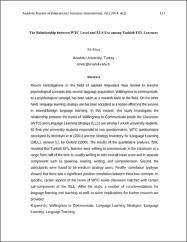The relationship between WTC level and LLS use among Turkish EFL learners

Göster/
Erişim
info:eu-repo/semantics/openAccessTarih
2014Yazar
Anadolu Üniversitesi
Merç, Ali
Üst veri
Tüm öğe kaydını gösterKünye
Merç, A. (2014). The relationship between WTC level and LLS use among Turkish EFL learners. Anadolu Journal of Educational Sciences International (AJESI), 4 (2), 133-161.Özet
Recent investigations in the field of applied linguistics have tended to transfer
psychological concepts into second language acquisition. Willingness to communicate,
as a psychological concept, has been taken as a research topic in the field. On the other
hand, language learning strategy use has been accepted as a notion affecting the success
in second/foreign language learning. In this respect, this study investigates the
relationship between the levels of Willingness to Communicate inside the Classroom
(WTC) and Language Learning Strategy (LLS) use among Turkish university students.
80 first-year university students responded to two questionnaires: WTC questionnaire
developed by McIntyre et al (2001) and the Strategy Inventory for Language Learning
(SILL), version 5.1 by Oxford (1990). The results of the quantitative analyses, first,
revealed that Turkish EFL learners were willing to communicate in the classroom in a
range from half of the time to usually willing in both overall mean score and in separate
components such as speaking, reading, writing, and comprehension. Second, the
participants were found to be medium strategy users. Finally, correlation analyses
showed that there was a significant positive correlation between these two concepts. In
specific, certain aspects of the levels of WTC inside classroom matched with certain
sub-components of the SILL. After the study, a number of recommendations for
language learning and teaching as well as some implications for further research are
provided.

















